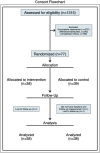Home blood pressure during night-time sleep - a feasible treatment target for patients with hypertension: a proof-of-concept randomised controlled trial
- PMID: 39968319
- PMCID: PMC11834773
- DOI: 10.1080/20523211.2025.2463435
Home blood pressure during night-time sleep - a feasible treatment target for patients with hypertension: a proof-of-concept randomised controlled trial
Abstract
Background: This trial assessed the feasibility of titrating evening dosing of anti-hypertensive medications based on nighttime home blood pressure measurement (HBPM) readings in primary care for hypertensive (HT) patients.
Methods: 78 patients with nocturnal HT and stage I daytime HT were randomly assigned in a 1:1 ratio to either nighttime HBPM measurements (intervention group) or daytime HBPM measurements (control group). Nighttime blood pressure (BP) was measured 3x per night for at least two nights over 1 week using an automatic and validated HBPM device. The intervention group and control group aimed to achieve systolic BP <120 mmHg on nocturnal HBPM and systolic BP <135 mmHg on daytime HBPM respectively. All patients were seen every four weeks and followed the same drug titration algorithm.
Results: The trial achieved a recruitment rate of 6.5 persons per month and a retention rate of 96.1%. In the intervention group, patients provided ≥6 (considered adequate) and ≥9 nighttime HBPM readings for 77.5% and 63.8% of their follow-ups, respectively. At 6-month, both groups had similar nighttime, 24-hour, and daytime BP on ambulatory BP monitoring, as well as similar numbers of non-dippers and healthcare utilisation. Most patients reported that they learned more from their HBPM nighttime readings and found the intervention well-tolerated.
Conclusion: Adjusting evening dosage of anti-HT medications based on nighttime HBPM is a potential and feasible treatment approach for patients with nocturnal HT in primary care. This approach is well-accepted by patients and results in at least non-inferior BP control. Although titrating medications according to nighttime HBPM readings may improve nighttime BP, the small sample size limited statistical significance and the single-centre design restricted generalizability. Additionally, a few patients exhibited fair adherence to nighttime HBPM. Further randomised controlled trials are required to confirm that targeting nocturnal BP should be the primary treatment goal for HT.
Keywords: Blood pressure; home blood pressure measurement; hypertension; randomised controlled trial.
© 2025 The Author(s). Published by Informa UK Limited, trading as Taylor & Francis Group.
Conflict of interest statement
No potential conflict of interest was reported by the author(s).
Similar articles
-
Home blood pressure measurement for hypertension management in the real world: Do not just measure, but share with your physician.Front Cardiovasc Med. 2023 Jan 18;10:1103216. doi: 10.3389/fcvm.2023.1103216. eCollection 2023. Front Cardiovasc Med. 2023. PMID: 36742078 Free PMC article.
-
When and how to use ambulatory blood pressure monitoring and home blood pressure monitoring for managing hypertension.Clin Hypertens. 2024 Apr 1;30(1):10. doi: 10.1186/s40885-024-00265-w. Clin Hypertens. 2024. PMID: 38556887 Free PMC article. Review.
-
Call to action on use and reimbursement for home blood pressure monitoring: Executive Summary. A joint scientific statement from the American Heart Association, American Society of Hypertension, and Preventive Cardiovascular Nurses Association.J Clin Hypertens (Greenwich). 2008 Jun;10(6):467-76. doi: 10.1111/j.1751-7176.2008.08418.x. J Clin Hypertens (Greenwich). 2008. PMID: 18550937 Free PMC article.
-
Call to action on use and reimbursement for home blood pressure monitoring: executive summary: a joint scientific statement from the American Heart Association, American Society Of Hypertension, and Preventive Cardiovascular Nurses Association.Hypertension. 2008 Jul;52(1):1-9. doi: 10.1161/HYPERTENSIONAHA.107.189011. Epub 2008 May 22. Hypertension. 2008. PMID: 18497371
-
Clinical significance of nocturnal home blood pressure monitoring and nocturnal hypertension in Asia.J Clin Hypertens (Greenwich). 2021 Mar;23(3):457-466. doi: 10.1111/jch.14218. Epub 2021 Feb 16. J Clin Hypertens (Greenwich). 2021. PMID: 33591641 Free PMC article. Review.
Cited by
-
Advancements in Wearable and Implantable BioMEMS Devices: Transforming Healthcare Through Technology.Micromachines (Basel). 2025 Apr 28;16(5):522. doi: 10.3390/mi16050522. Micromachines (Basel). 2025. PMID: 40428648 Free PMC article. Review.
References
-
- Burnier, M., Kreutz, R., Narkiewicz, K., Kjeldsen, S., Oparil, S., & Mancia, G. (2020). Circadian variations in blood pressure and their implications for the administration of antihypertensive drugs: Is dosing in the evening better than in the morning? Journal of Hypertension, 38(8), 1396–1406. 10.1097/HJH.0000000000002532 - DOI - PubMed
-
- Fujiwara, T., Tomitani, N., Kanegae, H., & Kario, K. (2018). Comparative effects of valsartan plus either cilnidipine or hydrochlorothiazide on home morning blood pressure surge evaluated by information and communication technology–based nocturnal home blood pressure monitoring. The Journal of Clinical Hypertension, 20(1), 159–167. 10.1111/jch.13154 - DOI - PMC - PubMed
-
- Hermida, R. C., Crespo, J. J., Domínguez-Sardiña, M., Otero, A., Moya, A., Ríos, M. T., Sineiro, E., Castiñeira, M. C., Callejas, P. A., & Pousa, L. (2020). Bedtime hypertension treatment improves cardiovascular risk reduction: The Hygia chronotherapy trial. European Heart Journal, 41(48), 4565–4576. 10.1093/eurheartj/ehz754 - DOI - PubMed
-
- Imai, Y., Asayama, K., Fujiwara, S., Saito, K., Sato, H., Haga, T., Satoh, M., Murakami, T., Metoki, H., & Kikuya, M. (2018). Development and evaluation of a home nocturnal blood pressure monitoring system using a wrist-cuff device. Blood Pressure Monitoring, 23(6), 318–326. 10.1097/MBP.0000000000000351 - DOI - PubMed
LinkOut - more resources
Full Text Sources

